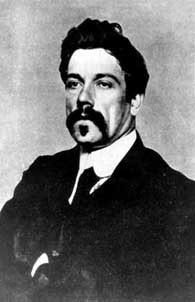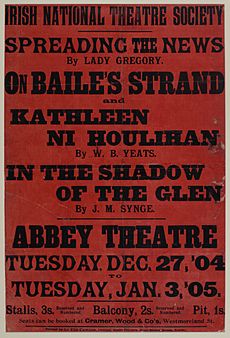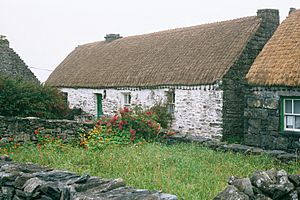John Millington Synge facts for kids
Quick facts for kids
John Millington Synge
|
|
|---|---|

John Millington Synge
|
|
| Born |
Edmund John Millington Synge
16 April 1871 Rathfarnham, County Dublin, Ireland
|
| Died | 24 March 1909 (aged 37) Elpis Nursing Home, Dublin, Ireland
|
| Nationality | Irish |
| Occupation | Novelist, short story writer, playwright, poet, essayist |
| Known for | Drama, fictional prose |
| Movement | Folklore Irish Literary Revival |
Edmund John Millington Synge (born April 16, 1871 – died March 24, 1909) was an important Irish writer. He was a playwright, poet, and collector of old stories and traditions, known as folklore. Synge was a key figure in the Irish Literary Revival, a time when Irish culture and literature became very popular.
His most famous play is The Playboy of the Western World. When it first opened, some people didn't like it. They found its ending sad and thought it showed Irish country people in a bad light. It also caused riots in Dublin when it was first performed at the Abbey Theatre. Synge helped start the Abbey Theatre with W. B. Yeats and Lady Gregory.
Other important plays by Synge include In the Shadow of the Glen (1903), Riders to the Sea (1904), The Well of the Saints (1905), and The Tinker's Wedding (1909). Even though he came from a rich family, his plays were mostly about working-class people in the Irish countryside.
Synge was often sick throughout his life. He was taught at home because of his poor health. He first loved music and even got a scholarship to Trinity College Dublin. He went to Germany in 1893 to study music. But in 1894, he decided to become a writer instead. He moved to Paris, where he met the famous poet W. B. Yeats. Synge then returned to Ireland.
He died at just 37 years old from a type of cancer called Hodgkin's disease. He was writing his play Deirdre of the Sorrows when he died. Many people think this unfinished play is one of his best works. Even though he didn't write many works, they are still very important in Irish culture.
Contents
About John Millington Synge
His Early Life
John Millington Synge was born on April 16, 1871. He was the youngest of eight children. His family was well-off and Protestant, living in Rathfarnham, County Dublin. His father, John Hatch Synge, was a lawyer. His family came from a long line of landed gentry (rich landowners) in Glanmore Castle, County Wicklow.
Synge's father died in 1872 when John was only one year old. His mother then moved the family to a house next door to her own mother's home. Even though Synge was often sick, he had a happy childhood there. He loved watching birds along the River Dodder. He also enjoyed family holidays by the sea in Greystones, County Wicklow, and at the family's estate in Glanmore.
Synge was mostly taught at home. He also went to schools in Dublin and Bray for a while. He learned to play the piano, flute, and violin. He also studied music theory at the Royal Irish Academy of Music. He was a very good student and won a scholarship for music in 1891.
In 1888, his family moved to Kingstown (now Dún Laoghaire). The next year, Synge started at Trinity College, Dublin. He earned a degree in 1892. He studied Irish and Hebrew, and kept up his music studies. He even played with the Academy Orchestra.
Synge later became interested in old Irish things and the Aran Islands. He joined the Irish League for a year. But he left because he wanted to help Ireland in his own way. He didn't want to be part of a political or military group. In 1893, he published his first known work, a poem.
Becoming a Writer
After college, Synge went to Germany to study music. He lived in Coblenz in 1893 and then in Würzburg in 1894. But he was shy about performing in public. He also wasn't sure if he was good enough at music. So, he decided to stop studying music and focus on writing.
He came back to Ireland in June 1894. Then, in January 1895, he moved to Paris. There, he studied literature and languages at the Sorbonne.
In 1896, he traveled to Italy to learn the language. He then returned to Paris. He planned to write about French authors for English newspapers. That same year, he met W. B. Yeats. Yeats told him to live for a while in the Aran Islands. He suggested Synge then return to Dublin and focus on creative writing.
In 1899, Synge joined Yeats, Augusta, Lady Gregory, and George William Russell. They formed the Irish National Theatre Society. This group later created the famous Abbey Theatre. Synge also wrote some literary reviews and early poems. He also went to lectures about Celtic history in Paris.
The Aran Islands and His Plays
In 1897, Synge had his first attack of Hodgkin's disease. A swollen gland was removed from his neck. He visited Lady Gregory's home, Coole Park. There, he met Yeats again and also Edward Martyn. For the next five summers, Synge spent time in the Aran Islands. He collected stories and old traditions. He also improved his Irish language skills. For most of the rest of the year, he lived in Paris. He also visited Brittany often.
During this time, he wrote his first play, When the Moon Has Set. He sent it to Lady Gregory in 1900, but she didn't want to produce it. This play was only published much later in his Collected Works.
Synge's first writings about life on the Aran Islands were published in 1898. His book, The Aran Islands, was finished in 1901 and published in 1907. It had pictures by Jack Butler Yeats. Synge thought this book was "my first serious piece of work." Lady Gregory read it and suggested changes, but Synge wanted it to be realistic. The book shows Synge's idea that under the islanders' Catholic faith, there were still old pagan beliefs from their ancestors. His time in the Aran Islands gave him ideas for his plays about Irish country life.
Synge moved from Paris to London in 1903. He had written two short plays the year before: Riders to the Sea and The Shadow of the Glen. Lady Gregory liked them. The Shadow of the Glen was performed in October 1903. Riders to the Sea was staged in February 1904.
The Shadow of the Glen was part of the first shows at the Abbey Theatre in December 1904. Both plays were based on stories Synge heard in the Aran Islands. He used props from the islands to make the stage look real. He also used the English dialect spoken in Ireland, called Hiberno-English. He believed this dialect was good for writing, partly because he thought the Irish language might not last.
The Shadow of the Glen is about a wife who is not faithful. Some people, like the Irish nationalist leader Arthur Griffith, criticized it. They said it was "a slur on Irish womanhood." Years later, Synge wrote that he heard conversations from servant girls in a kitchen, which helped him write the play. Griffith's criticism led to more attacks, saying Synge showed Irish women unfairly.
Riders to the Sea was also criticized by nationalists. They didn't like Synge's views on God and religion. People like Patrick Pearse and Arthur Griffith said Synge didn't help Irish nationalism. They thought he should have made his characters more perfect. But later critics said he actually made the Irish country people seem too perfect.
Synge also wrote another short play, The Tinker's Wedding. He didn't try to have it performed at first. This was because it had a scene where a priest is tied up in a sack. Synge thought this would upset "a good many of our Dublin friends."
When the Abbey Theatre was created, Synge became a literary adviser. He was also one of the directors, along with Yeats and Lady Gregory.
Synge's next play, The Well of the Saints, was performed at the Abbey in 1905. Again, some nationalists didn't like it. It was also performed in Berlin in 1906. One critic said the play mixed "lyric and dirt."
His Death
Synge died from Hodgkin lymphoma (a type of cancer) on March 24, 1909. He was only 37 years old. He passed away at the Elpis Nursing Home in Dublin. He was buried in Mount Jerome Cemetery in Dublin.
A book of his poems and translations was published soon after his death. Yeats wrote the introduction for it. Yeats and actress Molly Allgood (who was once engaged to Synge) finished his last play, Deirdre of the Sorrows. The Abbey Theatre performed it on January 13, 1910, with Molly Allgood playing Deirdre.
His Personality
John Masefield, who knew Synge, said he seemed like a "strange personality." Masefield thought Synge's view of life came from his poor health. He felt that Synge "clutched at life" and especially at "violent life," like someone who is sick might do.
Yeats described Synge as quiet and shy. He said Synge "never spoke an unkind word." Yet, his art could "fill the streets with rioters" because of the strong reactions it caused. Richard Ellmann, who wrote about Yeats, said Synge "built a fantastic drama out of Irish life."
Yeats wrote about Synge in his poem "In Memory of Major Robert Gregory":
- And that enquiring man John Synge comes next,
- That dying chose the living world for text
- And never could have rested in the tomb
- But that, long travelling, he had come
- Towards nightfall upon certain set apart
- In a most desolate stony place,
- Towards nightfall upon a race
- Passionate and simple like his heart.
Synge was also interested in changing society. He read about socialism and wanted to make big changes. His mother was worried about this. He went to Paris in 1896 to get more involved in these ideas. He remained interested in them until he died.
His Legacy
Yeats called Synge "the greatest dramatic genius of Ireland." Yeats and Lady Gregory were central to the Irish theatre movement. But it was Synge who gave the movement its special Irish quality. His plays helped shape the style of the Abbey Theatre until the 1940s. The realistic style of his writing influenced how actors were trained at the theatre. Plays about country life were very common there until the late 1950s.
Other important Irish writers were influenced by Synge. Sean O'Casey, another major playwright for the Abbey, knew Synge's work well. He tried to do for the working classes of Dublin what Synge had done for the poor people in the countryside. Writers like Brendan Behan, Brinsley MacNamara, and Lennox Robinson were all inspired by Synge.
The Irish writer Vivian Mercier was one of the first to notice how Samuel Beckett was influenced by Synge. Beckett often watched plays at the Abbey when he was young. He especially liked the plays of Yeats, Synge, and O'Casey. Mercier pointed out that Synge's characters, like tramps, beggars, and country people, are similar to many characters in Beckett's books and plays.
Synge's old cottage in the Aran Islands has been fixed up. It is now a place tourists can visit. Every summer since 1991, there has been an annual Synge Summer School in Rathdrum, County Wicklow. Synge is also the subject of a 1999 documentary film called Synge agus an Domhan Thiar (Synge and the Western World). Joseph O'Connor wrote a novel, Ghost Light (2010), which is loosely based on Synge's relationship with Molly Allgood.
Synge's letters with his cousin, the composer Mary Helena Synge, are kept at Trinity College Dublin.
His Works
- In the Shadow of the Glen, 1903
- Riders to the Sea, 1904
- The Well of the Saints, 1905
- The Aran Islands, 1907 (The book at wikisource: The Aran Islands)
- The Playboy of the Western World, 1907
- The Tinker's Wedding, 1908
- Poems and Translations, 1909
- Deirdre of the Sorrows 1910
- In Wicklow and West Kerry, 1912
- Collected Works of John Millington Synge 4 vols, 1962–1968
- Volume 1 Poems, 1962
- Volume 2 Prose, 1966
- Volumes 3 and 4 Plays, 1968
See also
 In Spanish: John Millington Synge para niños
In Spanish: John Millington Synge para niños




